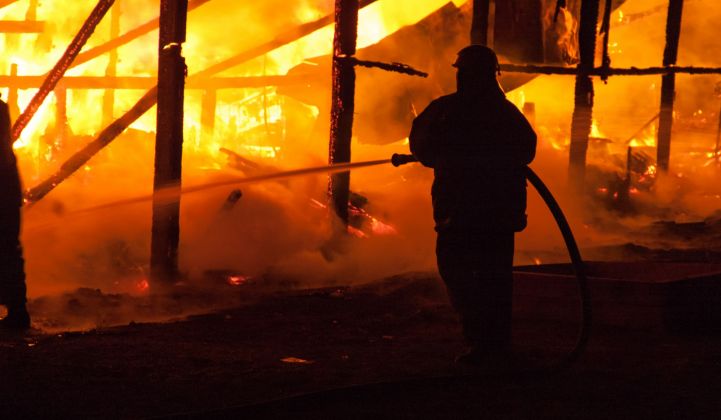Pacific Gas & Electric has detailed why it decided not to de-energize the power lines that may have caused this month’s deadly Camp Fire, saying in a Tuesday report that high winds and dry conditions never reached the threshold that would trigger a "public safety power shutoff."
But the utility’s decision is being questioned by critics who say California’s utilities must cut electricity more aggressively to reduce what could be the primary cause of the state’s increasingly deadly wildfires.
Tuesday’s report from PG&E to the California Public Utilities Commission breaks down the day-by-day decision-making process that led it to cancel a possible power shutoff in the days leading up to the Camp Fire.
On Nov. 6, two days before the fire began, it activated its Emergency Operations Center, and informed about 70,000 customers that it might shut off power. The next day, it refined the forecasted impact down to 63,000 customers and eight counties, while monitoring weather conditions that were “nearing but not reaching forecasted levels that would warrant temporarily turning off power for customer safety.”
But by the afternoon of Nov. 8, when PG&E called off its planned de-energizing exercise, the Camp Fire had already been blazing for hours. And while the cause of the fire hasn’t yet been determined, PG&E reported a day after the fire began that one of its high-voltage transmission lines had suffered an outage at a time and place close to where investigators say the fire began, and that an aerial patrol had revealed damage to a transmission tower in that area.
This potential link between a wind-damaged transmission line and the start of what’s become California’s deadliest wildfire, with at least 88 people confirmed dead, has drawn increased scrutiny to how PG&E and other utilities should manage their electrical grids to prevent more fires from starting.
“We need to be turning the power off much more,” Michael Wara, director of the Climate and Energy Policy Program at Stanford University’s Woods Institute for the Environment, wrote in a Wednesday tweet. “Not meeting the shutoff criteria is not evidence of safety.”
Wara wrote that “actual conditions appear to have exceeded [the] threshold for shutoff” in the region where the fire started. While PG&E noted in its report that “no single factor” triggers a public safety power shutoff, it did list a set of criteria including humidity at or below 20 percent, sustained winds above 25 mph and wind gusts in excess of 45 mph, and a consideration of the local temperature, terrain and dryness of dead and living vegetation that could become the fire’s fuel.
But the Los Angeles Times noted that a weather station near Paradise, the town almost completely destroyed by the Camp Fire, recorded wind gusts of 52 mph hours before the fire was first reported.
Wara also noted that PG&E’s power shutoff plans are focused on its low- and medium-voltage distribution grids below 70 kilovolts — a standard that wouldn’t have led to the de-energizing of the 115-kilovolt Caribou-Palermo transmission line that malfunctioned at the time and place linked to the Camp Fire’s ignition.
PG&E has seen its stock price punished and its credit rating downgraded in the wake of the fire, and state regulators and legislators have moved quickly to institute policies that could help shield the utility from the threat of bankruptcy if it ends up being found liable for the multibillion-dollar damages involved.
PG&E’s public safety power shutdown policy was put into effect after last year’s deadly Tubbs Fire in California wine country, the cause of which is still being investigated, and a number of other smaller but still deadly wildfires that California fire investigators have concluded were caused by the utility’s power lines.
To be sure, utility power shutoffs can have significant downsides. PG&E instituted its first public safety shutoff last month, cutting electricity to about 60,000 customers in seven counties over two days of high winds. In its report on that incident, PG&E reported that it has received a total of 146 claims from customers who said they’d been damaged by the loss of electricity, including 25 claims of economic impacts due to business interruption, and 102 claims of food spoilage or loss. These are claims the utility said it does not plan to reimburse, due to the public safety nature of the event.
But the decision may have indeed prevented fires from starting, according to PG&E patrols that found more than 20 “instances of wind-related issues across impacted divisions that required remediation prior to re-energizing.” This included 18 instances of damage to PG&E equipment, 15 of which appear to have been caused by falling vegetation, and five cases of vegetation-related hazards such as branches found lying across conductors.
Wara noted in a Wednesday tweet that electrical equipment appears to be the cause of most of the state’s 20 most destructive wildfires, responsible for up to two-thirds of the loss of life, and nearly three-quarters of the property losses, recorded from those fires. However, he warned that this analysis presumes that the Tubbs, Woolsey, Thomas and Atlas fires were also started by power lines, a finding that’s supported by “strong circumstantial evidence” but has yet to be officially made by California fire investigators.
Even so, the “bottom line” is that “catastrophic wildfires are mostly a problem of trees falling into (live) wires,” he wrote. “If we solve that problem — either by removing the trees, removing the wires, or turning the wires off — we solve the problem of catastrophic wildfire in California.”




